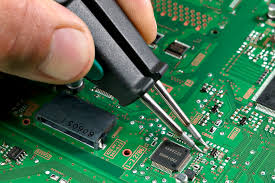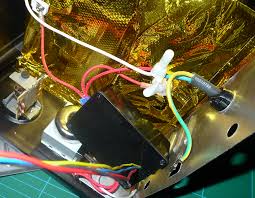 Manufacturing based on Surface-Mounted Technology has taken over electrical engineering, and for good reason. Rather than using space-hungry holes through the board, SMT-based circuits have components which are placed directly onto the board, using a solder paste which also works as a glue.
Manufacturing based on Surface-Mounted Technology has taken over electrical engineering, and for good reason. Rather than using space-hungry holes through the board, SMT-based circuits have components which are placed directly onto the board, using a solder paste which also works as a glue.
The hard part is the baking that follows. While there are several possible techniques, the board has to be precisely raised to temperatures in excess of 200 degrees, to properly melt the solder. Much like when cooking dinner, too little or too much heat can quickly ruin the project.
Modern manufacturers utilizing surface mounted technology use all-in-one devices called Reflow Soldering Ovens to ensure proper circuit boards. These marvels of engineering can automatically handle the heating and cooling of each circuit board, sending it through a series of internal chambers for treatment.
The Zones Of A Reflow Soldering Oven
1 - Preheating
The first and lengthiest stage is the pre-heating of the circuit, which requires bringing it up to a given temperature slowly. The heat distribution must be uniform, or the board could warp. This stage can last several minutes, as the temperature is only raised by about 3-5 degrees Fahrenheit per second.
2 - Thermal Soak
Having reached the desired pre-heating point, the board passes to the second chamber for a thermal soak at that temperature, for 60-120 seconds. This ensures even heat distribution, as well as activating chemicals in the solder paste that prevent the solder from turning into microbeads, which it otherwise would.
Once the thermal soak is finished and the piece moves on, the board should be at thermal equilibrium.
3 - Reflow
The heart of the reflow soldering process happens here, where the circuit board is rapidly heated to maximum temperatures to fully melt the solder and bond it to the circuit board. Several heating methods can be used here, although conventional convection baking is still the most common.
Timing is crucial here, as the solder must melt fully without having time to flow off the board or start vaporizing. This process generally takes 30-40 seconds.
4 - Cooling
The fourth chamber quickly cools the board, down to temperatures of 86 Degrees Fahrenheit. The cooling is more rapid than the heating, as fast cooling encourages the solder to form into a crystalline structure which creates a superior bond to the underlying board.
5 - Washing
Not all manufacturing centers include a washing process, but they should - it's now commonly accepted by standards agencies such as the IPC. Most forms of solder paste leave a chemical residue, even those considered "no clean." Additionally, microscopic grit could have made its way onto the board during the manufacturing process.
So, the final step is washing the finished circuit, usually with simple deionized water and a mild detergent followed by air-drying. In some cases, special solvents may be used.
SMT Creates Superior Circuit Boards
The result of all this is a finished SMT circuit board which is smaller, more efficient, and more resistant to vibrations than older through-hole circuit boards. Precision computer-controlled reflow ovens guarantee superior final products, again and again.
Is your manufacture using the most up-to-date SMT production techniques? If not, it might be time for a change. Contact ZenTech today for more information on what modernized American manufacturing can do for your products.





